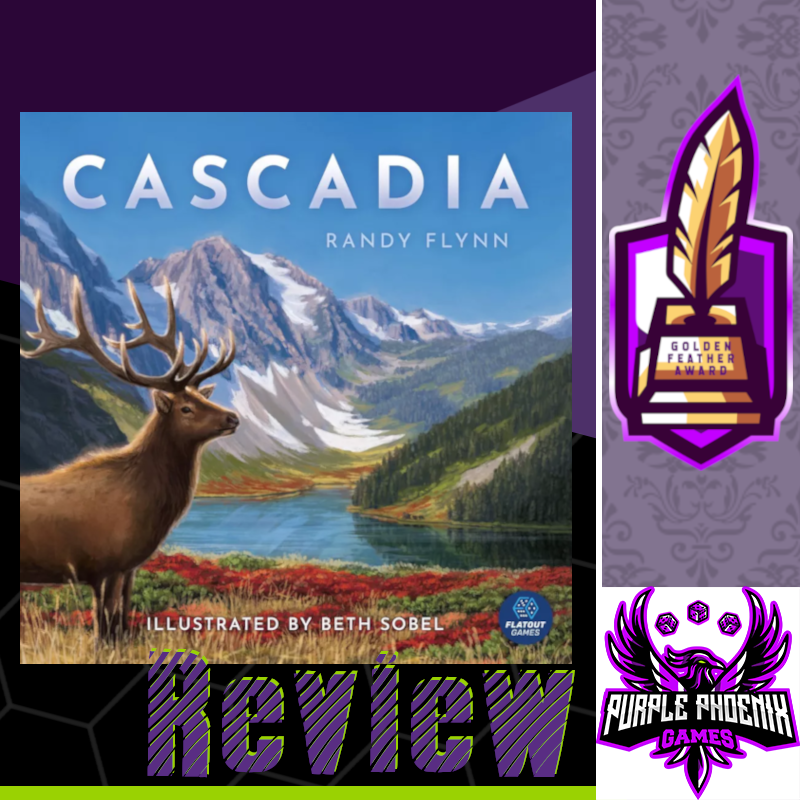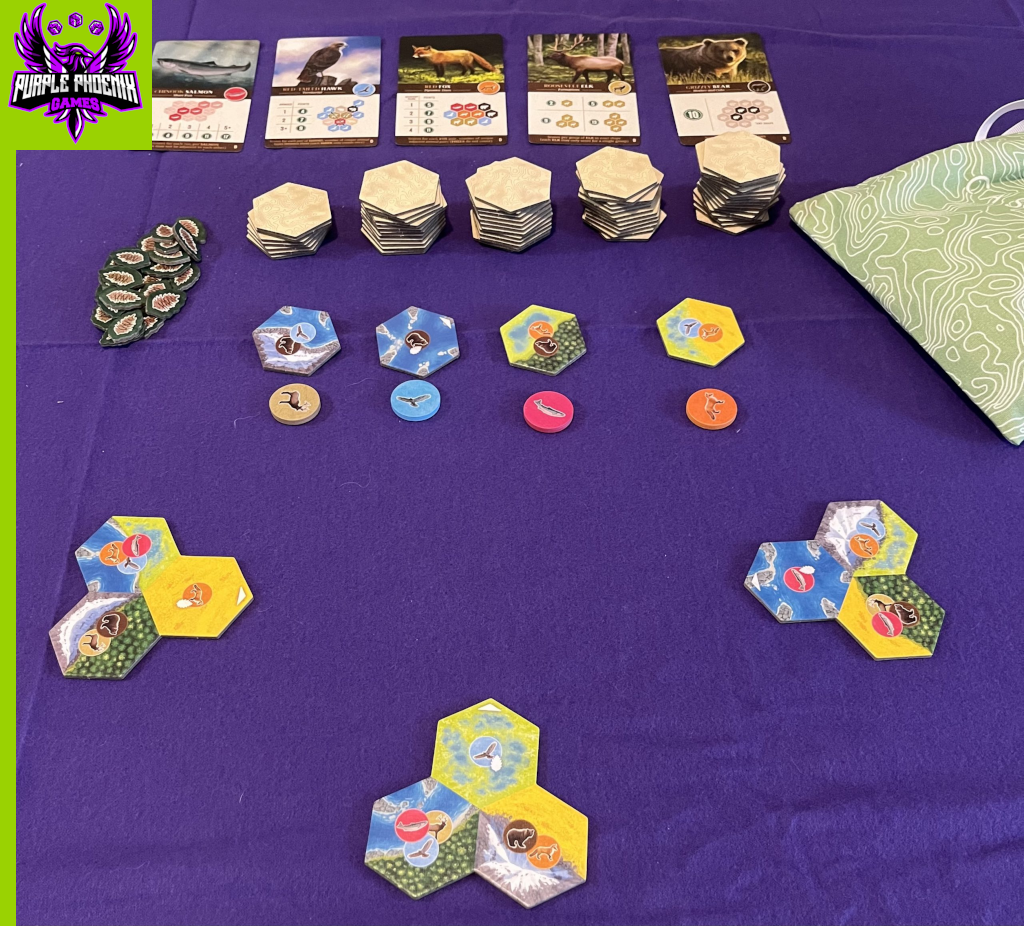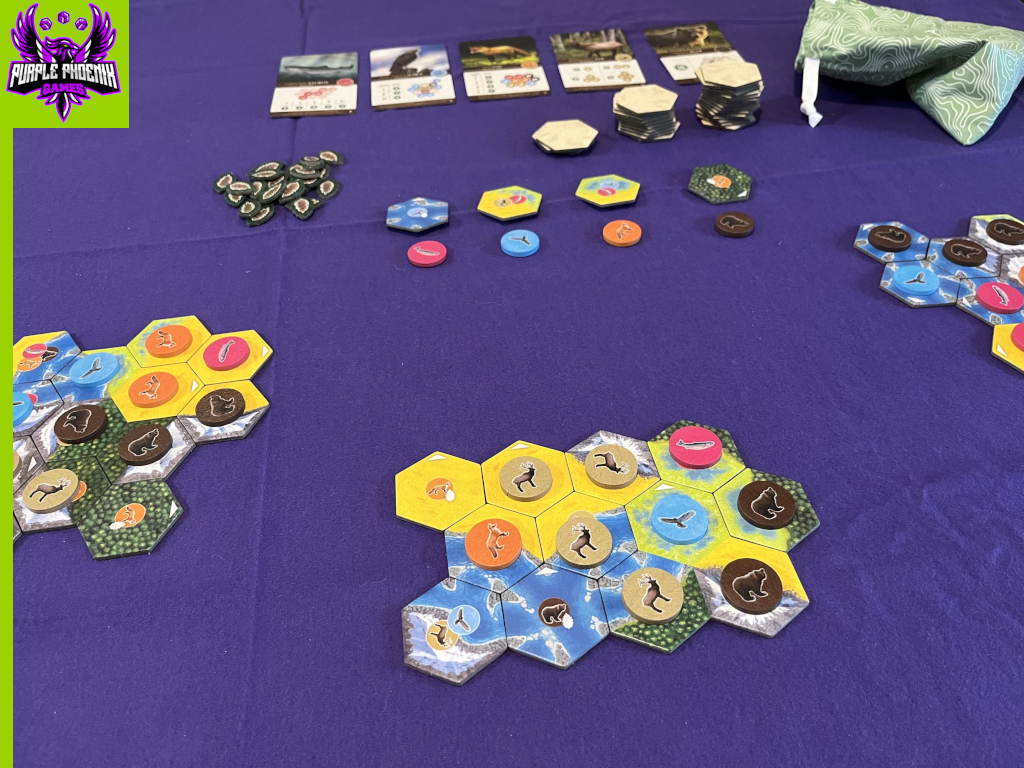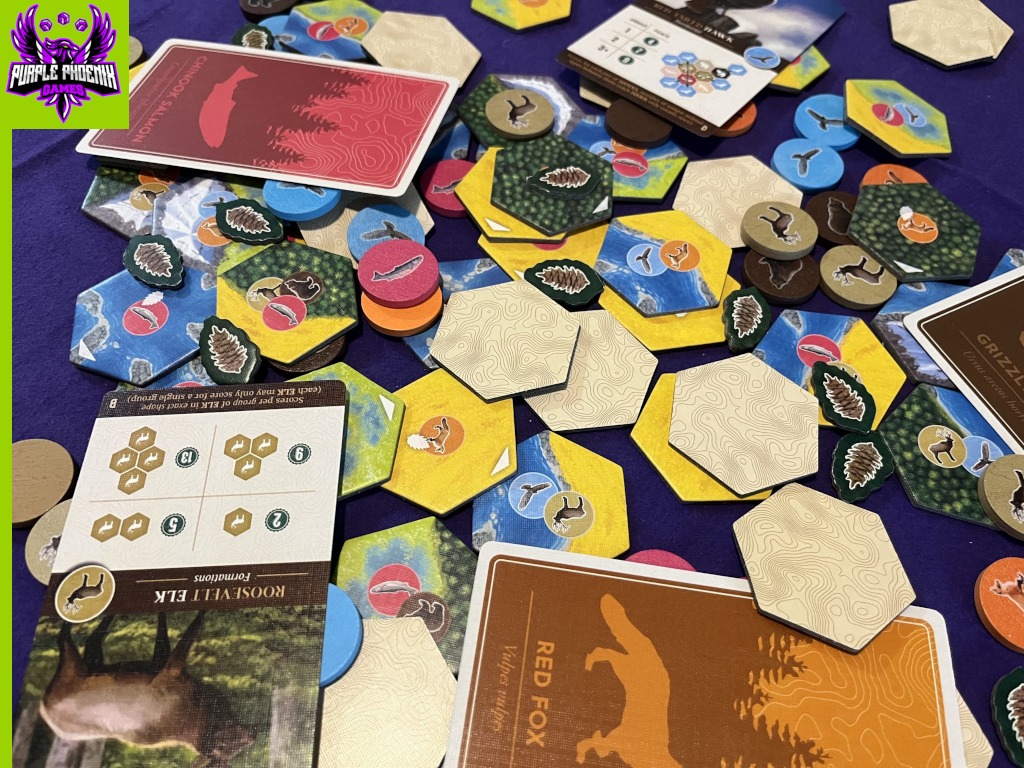
We haven’t had a Golden Feather winner in quite some time, but Cascadia has done it! This tile-laying, token-drafting spatial puzzle impressed both Travis and me from our very first play. The artwork alone makes it fun to have on the table, and the strategy offered within is what takes it over the top. If you haven’t had a chance yet to check out Cascadia, get your hands on a copy ASAP. You won’t be disappointed. Read on to see why.
| Cascadia (2021) | AEG/Flatout Games |
| 1-4 players | 30-45 min. |
| Ages 10+ | BGG Weight – 1.87 / 5 |
Cascadia is a game for 1-4 players in which players will be drafting tiles and tokens, placing them in their tableau, and creating a geographic expanse to earn end-game points. To setup for the game, create the stacks of Habitat Tiles (depending on the player count), and place them face-down in the middle of the table. Put all the Wildlife Tokens in the cloth bag and shake it up. Randomly choose a Wildlife Scoring Card for each of the 5 different types of Wildlife, and set them off to the side within view of all players. Create a face-up ‘market’ of 4 Habitat Tiles from the stacks, and draw 4 Wildlife Tokens from the bag, one at a time, and pair them each with a Habitat Tile. Nature Tokens are placed off to the side, and each player receives a random Starter Habitat Tile. Choose a starting player, and the game is ready to begin! Pictured below is the setup for a 3-player game.

Over a series of turns, players will be drafting pairs of Habitat Tiles and Wildlife Tokens and adding them to their environment (personal tableau). To start your turn, you will select a Habitat Tile/Wildlife Token pair from the market. The pairs in the market are set, and you must select a given pairing. Once you have picked your Habitat Tile and Wildlife Token, you will add them to your environment. Habitat Tiles are added to your environment with the following restrictions: the new tile must be placed adjacent to a tile already in your environment, and you may not place a Habitat Tile on top of another. So basically, you can add it anywhere in your environment, as long as it shares at least one side with another previously placed tile. Matching terrain types is not a placement rule, but it can earn you points at the end of the game, so place those tiles wisely!
Your Wildlife Token will be placed on a Habitat Tile in your environment with these restrictions: the Habitat Tile cannot already have a Wildlife Token on it, and the Habitat Tile you choose must have the matching Wildlife symbol on it. So don’t go trying to place Salmon in the mountains or forest! If you are unable to, or choose not to, place your Wildlife Token on your turn, simply return it to the bag. Certain Habitat Tiles are marked and considered Keystone Tiles, and placing a matching Wildlife Token on these will earn you a Nature Token. Nature Tokens can be used to take any pair of Habitat Tile/Wildlife Token during the start of your turn, or can be used to wipe the market and replace it (in case there are no choices you like!). So earning those Nature Tokens comes in handy for sure. At the end of your turn, after you have added your Habitat Tile and Wildlife Token to your environment, refill the market. Draw a face-down Habitat Tile and place it in the market row, and randomly draw a Wildlife Token from the bag to be paired with it. Your turn now ends, and play continues clockwise.
Once there are no more face-down Habitat Tiles to add to the market at the end of a player’s turn, the game ends and final scoring takes place. The first to score are the Wildlife Scoring Cards you randomly selected at the start of the game. Based on the placement of the 5 types of Wildlife Tokens in your environment, you will earn points for fulfilling their requirements. For example, Bears score for groups of adjacent Bear tokens, depending on how many Bears make up the group. Next, Habitat Tiles are scored for groups of matching terrain. You earn 1 point per tile of your biggest contiguous group of each of the 5 terrain types. When everyone has figured out their individual Habitat Tile scores, they now compare them to each other to see which player has the largest group of matching terrain amongst all players. Whomever has the largest of each terrain type earns extra bonus points! And finally, players earn 1 point for any Nature Tokens they still have at the end of the game. Add up the scores, and the player with the highest total is declared the winner!

As you could probably tell from our rating graphic and my intro, we absolutely love this game. The gameplay, strategy, components, theme, and artwork all meld together to create an excellent gaming experience. The gameplay itself is relatively simple – select a Tile/Token pair and place it in your environment. And that’s where the simplicity ends. The strategic options offered by Cascadia are seemingly endless, as you have many different paths to victory. First, you have the Wildlife Scoring Cards with the 5 different types of Wildlife represented in the game, that’s already 5 different routes you can go down in your attempt to earn points. And with a variety of scoring cards for each type of Wildlife and drawing one randomly each game, no two games will be the same. Next, you have your Habitat Tiles. The placement rules are pretty unrestricted, which means you can build your environment however you want. But with that comes 2 strategic elements to keep in mind. How can you place your Habitat Tiles to populate with Wildlife and earn points from those Scoring Cards? And how can you place your Habitat Tiles in a way to earn you points for each of the 5 different types of terrain? You have to always be thinking ahead with your strategy, because your Habitat Tile placement can offer more than one way to score points. You can’t just pick one area to focus on – success requires a balance of all strategic elements. And figuring out how to keep that balanced means your strategy is always changing and adapting each turn. Obviously, I give this game high praise for its gameplay and strategic implications.
To touch on components for a moment – they’re great. The Wildlife Tokens are nice wooden discs with the art printed on one side. The Habitat Tiles are thick, chunky cardboard that will definitely hold up to many plays. The Wildlife Scoring Cards are large, sturdy, and comprehensible. And can I mention the artwork?? Beth Sobel has done it again with another fantastically illustrated game. The colors, the attention to detail, the style – I could just sit and look at this game and have a good time. Of course I’d rather play it, but admiring it is pretty enjoyable too.
When Cascadia originally came out, I read all the hype about it and was intrigued. But I was never able to get my hands on a copy until quite some time later. And now I’m kicking myself for not making more of an effort earlier to grab a copy. Because this game is just awesome. I can absolutely see this staying in my collection forever, as all of its elements just hit the spot for me. Like I said earlier, if you haven’t had a chance to play Cascadia yet, do it as soon as possible. If your gaming tastes are similar to mine, then I think you’ll be in love too. As I’m writing this, I’m thinking about how I would play differently next time and what my main strategy would be. And to me, that’s the sign of a great game – it’s on your mind when you’re not even gaming. Purple Phoenix Games awards Cascadia with a Golden Feather Award. It is well deserved for sure!

